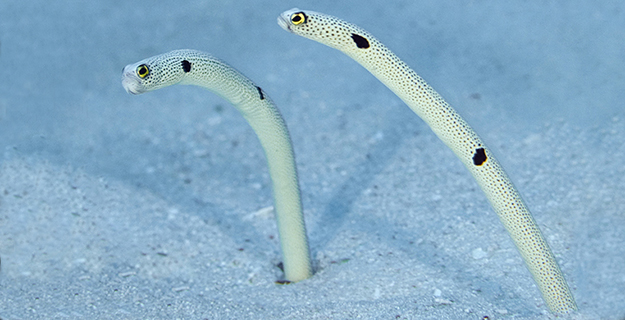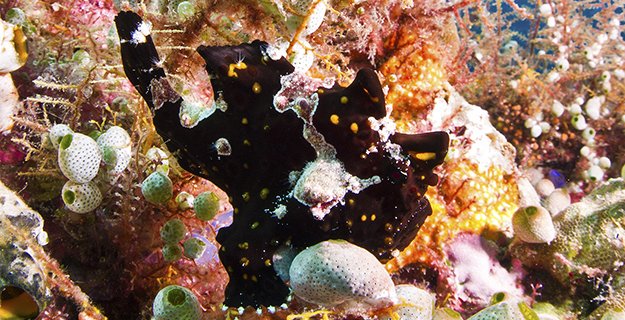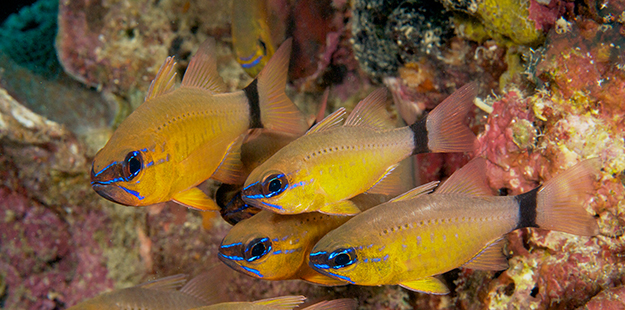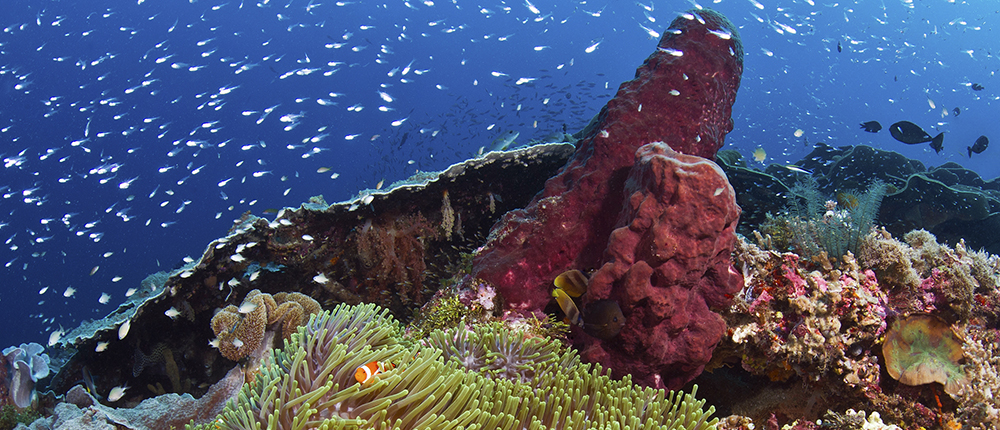Sunken Treasure
Discovering the underwater riches of Wakatobi’s favorite unmarked dive site
Guests at Wakatobi Resort have exclusive access to more than 40 world-class dive sites located within our marine reserve. With so much underwater diversity just a swim or a short boat ride away, it’s difficult for most divers to single out any one location as a favorite. But there are certain sites that always seem to inspire superlatives and requests for a return visit. Among these is one special site known as Treasure Chest. You won’t find it listed on most dive maps, but Wakatobi Resort’s dive guides known just where to look for this dazzling collection of underwater gems.

Just a 10-minute boat ride from the resort, a trio of seamounts rise from the depths. On the map you’ll see two listed, Waitii Ridge and Table Coral City. In between is a third equally intriguing site known as Treasure Chest. Photo by Didi Lotze
The middle of somewhere
A short distance beyond the northwestern edge of the House Reef, a trio of seamounts rise up from a deeper connecting ridge that lies just outside the fringing barrier reef connecting Onemobaa and Tomia Islands. Closest to the resort, Waiti Ridge leads to a prominent pinnacle festooned with pavona coral and feather stars. A quarter mile to the north, the 30-meter profile of aptly-named Table Coral City rises into the shallows, supporting luxuriant growths of hard coral colonies that harbor a wealth of marine life. In between these two structures, a third seamount rises from the ridge. This is the Treasure Chest, and though it is often excluded from maps and printed lists of area dive sites, it has become a guest favorite for a number of reasons.

To the south of Treasure Chest is Waitii Ridge, a prominent but small pinnacle featuring a variety of gorgonians and sponges festooned with feather stars and crinoids. Photo by Marco Fierli, marcof8.com
Treasure Chest is just a ten-minute boat ride from the resort, and is sheltered by the western edge of Tomia’s barrier reef. Currents are typically mild to non-existent, allowing divers to tour the site at a relaxed and leisurely swim pace. Like many sites at Wakatobi Resort, a bit of strategic dive planning will allow for an hour-plus dive that takes in a diverse range of flora and fauna, yet never edges divers close to a decompression obligation.

Divers who move in slow at the base of Treasure Chest’s slope can catch a glimpse of shy garden eels rising up from their burrows. Photo by Rob Darmanin
The lower east side
Most dives at Treasure Chest will begin with a swim down the steeper eastern face of the seamount. As they descend, divers may encounter schools of fusiliers and black snapper, and the slope often holds a group of bumphead parrotfish. Turtles frequent this area, and a school of chevron barracudas make regular patrols, causing any small fish caught in the open to dart for cover among the corals and gorgonians that cover the pinnacle face. As divers move deeper, the slope becomes more gradual, and transitions to a sand bottom at the 30-meter/100-foot mark. This deep sediment bed supports a colony of garden eels, and divers who move in slow and quiet can catch a glimpse of these shy creatures rising up from their burrows. There are hundreds of eels in this colony, and when they are up and looking about, with their long, thin bodies swaying, the sea floor resembles a field of undulating sea grass. Get too close, however, and the “grass” seems to disappear as the eels retreat into their subterranean burrows. It’s a fascinating sight, but most dive plans call for a short visit, as there’s still much to see, and lingering in the depths could curtail bottom time.

Treasure Chest is one of the best places in the Wakatobi marine preserve to locate a frogfish. Can you see the frogfish here? Photo by Warren Baverstock
Heading west
Ascending from the garden eel colony, divers are usually advised to swim to a depth of 60 feet, then follow the contours of the seamount around Treasure Chest’s connecting ridge to arrive at the western face. Here, where the slope faces blue water, sponges and large gorgonians thrive in the middle depths. This is prime hunting grounds for small stuff, and one of the best places in the Wakatobi marine preserve to locate a frogfish. Locating these stealthy, body-morphing reef dwellers takes patience and a keen eye for detail, as frogfish are famous for their ability to match both the color and sometimes even the shape of their surroundings. What may at first look like a small purple sponge growing from a rock may actually be a frogfish, holding motionless as it waits for a tasty morsel to drift within range of its vacuum cleaner-like mouth, or uses its built-in fishing lure to lure unsuspecting prey closer. Though hard to spot initially, frogfish don’t tend to move about much, and Wakatobi’s dive guides can usually point the way to a known frogfish lair.

The western face of Treasure Chest often features schools of trevally jack as they swoop to and from in an attempt to intercept small fish caught too far from shelter. Photo by Norbert Probst

A peek into a dark crevice may reveal a group of ring tailed cardinalfish, hanging in the shadows until the sun goes down. Photo by Steve Rosenberg
There’s plenty more to be found lurking in shelter of the hard and soft coral groves on the western flanks of Treasure Chest. A peek into a dark crevice may reveal a group of soldierfish, hanging in the shadows until the sun goes down. Gobies and blennies find refuge within the folds of lettuce coral formations and among the branches of sea fans, while patient crocodilefish watch from ambush points nearby. Out in the open, angelfish flit about, occasionally pausing to nibble on sponges. Divers my be graced with fly-bys from spotted eagle rays, and can watch giant trevally swoop to and from as they attempt to intercept small fish caught too far from shelter.
Topping it off
The crest of the Treasure Chest pinnacle rises to within 15 feet of the surface. When divers reach this upper realm, they are essentially making an extended safety stop—though few safety stops could match what awaits.


